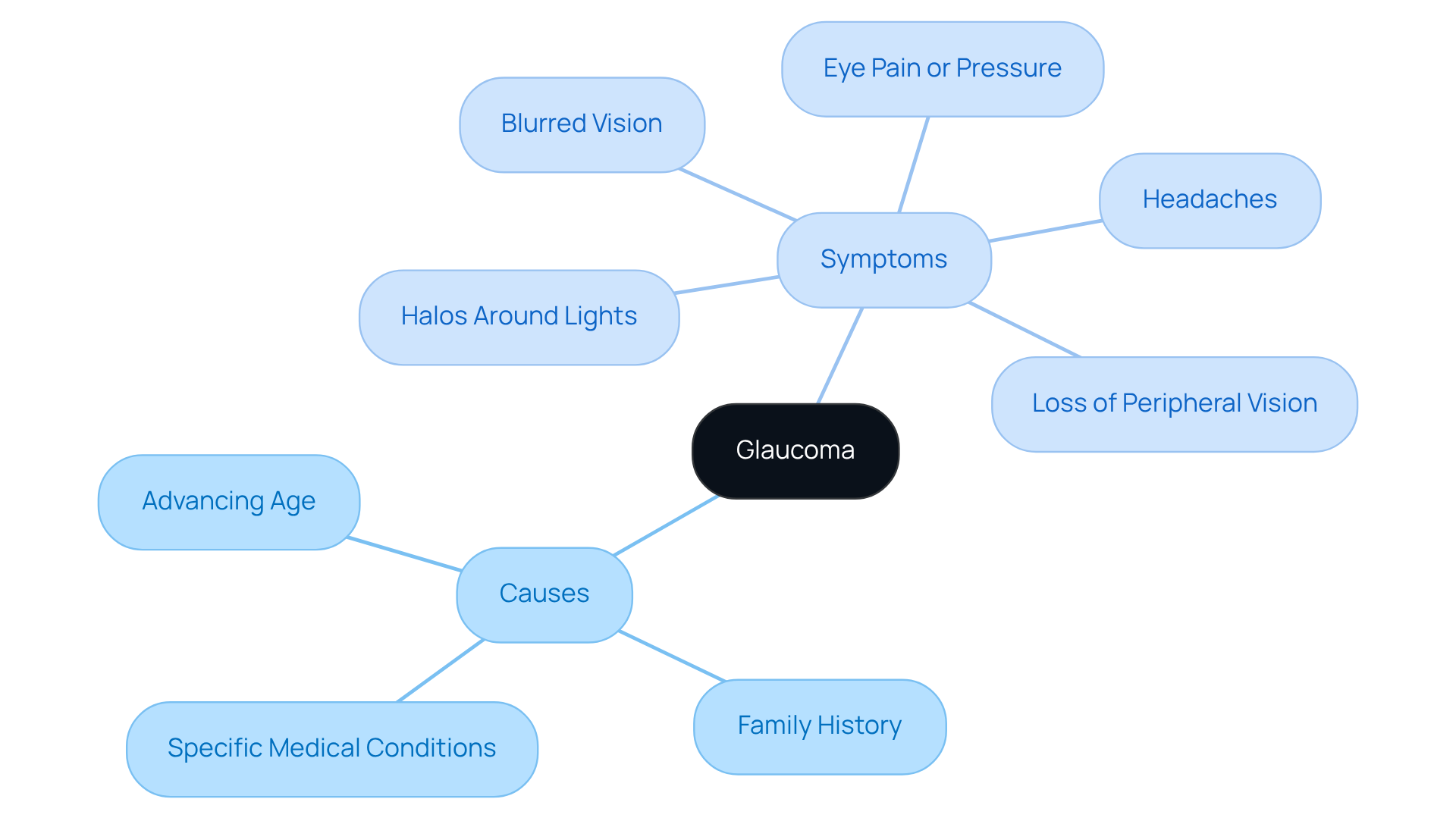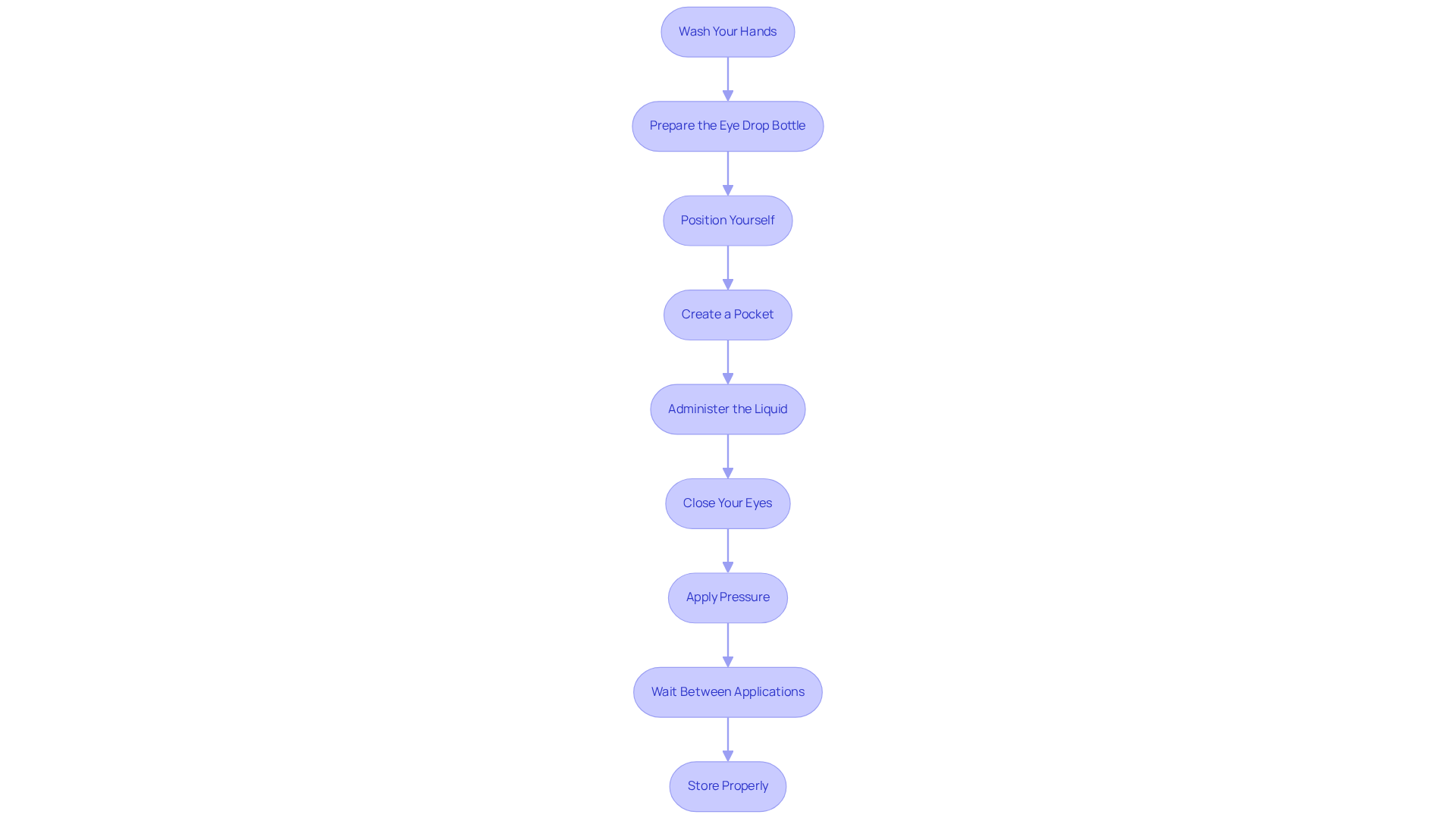Posted by: Northwest Eye in General on July 5, 2025
Overview
This article highlights the effective application of glaucoma eye drops, outlining a series of detailed steps to ensure proper usage and adherence to treatment. We understand that many patients may feel overwhelmed by the process, and it’s common to struggle with eye drop application due to misunderstandings. Research supports this, indicating a significant need for clear guidance. By following these steps, we aim to improve treatment efficacy and enhance eye health management, reassuring you that you are not alone in this journey.
Introduction
Understanding glaucoma is essential for maintaining eye health, and we recognize that many individuals face challenges with the proper application of glaucoma eye drops—a crucial part of their treatment regimen. This article offers a step-by-step guide to ensure effective application, empowering you to enhance your technique and compliance.
It’s common to feel overwhelmed, especially with challenges like aiming the dropper or remembering doses. But together, we can explore ways to overcome these obstacles and safeguard your vision.
Understand Glaucoma: Causes and Symptoms
Glaucoma encompasses a range of eye diseases that can harm the optic nerve, primarily due to elevated intraocular pressure (IOP). We understand that facing eye health concerns can be daunting, and it’s important to be aware of the signs. Open-angle eye disease, the most common type, often advances quietly, with symptoms appearing only after significant nerve damage has occurred. Common symptoms include:
- Blurred vision, which may indicate underlying conditions such as cataracts or diabetic retinopathy.
- Halos around lights, particularly noticeable in dim or dark environments, which can also signal deeper issues.
- Eye pain or pressure.
- Headaches.
- Loss of peripheral vision.
Recognizing these symptoms early is crucial. Timely intervention can significantly preserve your vision and prevent serious health complications. Chronic eye pressure issues can lead to total blindness if not addressed, underscoring the importance of routine eye check-ups. Factors that may increase your risk for this condition include family history, advancing age, and specific medical conditions. Awareness of these causes can encourage you to follow prescribed therapies, such as eye solutions, which are essential in managing glaucoma effectively. If you experience any of these symptoms, please seek professional medical help immediately. With more than 3 million Americans affected by this condition, understanding its implications is vital for encouraging proactive eye health management. Remember, we are here to help you through this process.

Follow Steps for Proper Eye Drop Application
To apply glaucoma eye drops effectively, we encourage you to follow these essential steps:
- Wash Your Hands: Begin by thoroughly washing your hands with soap and water to prevent infection. We understand that cleanliness is crucial for your health.
- Prepare the Eye Drop Bottle: Shake the bottle if instructed, and remove the cap without touching the dropper tip to avoid contamination. This small step can make a big difference.
- Position Yourself: Tilt your head back slightly or lie down flat to make the application of the liquid easier. It’s common to feel a bit awkward at first, but finding a comfortable position helps.
- Create a Pocket: With your non-dominant hand, gently pull down your lower eyelid to form a small pocket for the liquid. This technique is important for effective application.
- Administer the Liquid: Hold the dropper above the eye and squeeze one portion into the pocket, ensuring the dropper does not touch the eye. Remember, precision is key here.
- Close Your Eyes: After administering the liquid, gently close your eyes and refrain from blinking. This allows the medication to absorb effectively. It’s completely normal to feel a bit anxious during this step.
- Apply Pressure: Use your index finger to apply gentle pressure to the inner corner of your eye (near the nose) for 2-3 minutes. This technique helps prevent the medication from draining away. We know this might feel unusual, but it’s beneficial.
- Wait Between Applications: If several kinds of eye solutions are prescribed, wait at least 5 minutes between uses to ensure proper absorption of each medication. Patience is important in this process.
- Store Properly: Replace the cap on the bottle and store it as directed, typically in a cool, dry place. Proper storage helps maintain the effectiveness of your medication.
Real-life experiences show that many individuals struggle with these steps, often due to misunderstandings about the technique. For instance, research indicates that between 18.2% and 80% of individuals with glaucoma contaminate their eye medication containers by touching their eye or face during use. Moreover, just 16% of individuals report receiving sufficient guidance on the correct application of glaucoma eye drops from their healthcare professionals. This underscores the importance of following these steps closely to enhance treatment efficacy and maintain eye health. As Dr. Andrew Iwach observes, “Eye solutions can be challenging to administer.” We are here to help you through this process. By following these optimal methods, you can greatly enhance your eye medication application technique and overall compliance with treatment.

Troubleshoot Common Issues with Eye Drops
Patients frequently encounter various obstacles when using glaucoma eye drops as part of their therapy. We understand that this can be challenging, and we want to provide you with some common issues and effective troubleshooting tips to enhance your application process:
- Difficulty Aiming the Drop: If aiming the dropper proves challenging, consider using a mirror for better visibility or ask a trusted person for assistance. Practicing the technique of tilting your head back while looking up and gently pulling down your eyelid can also improve accuracy.
- Excessive Dispensing: To avoid several releases from dispensing simultaneously, practice squeezing the bottle gently. Holding the bottle slightly further away from your eye can also help control the flow.
- Liquid Not Entering the Eye: If you feel the liquid is not entering your eye, gently close your eyes after application and apply light pressure to the tear duct area for a few minutes. This technique can help the medication absorb more effectively.
- Annoyance or Unease: If the solution causes irritation, it’s recommended to consult your eye doctor. They may recommend an alternative formulation or suggest using artificial tears to alleviate discomfort.
- Forgetting to Apply Drops: To combat forgetfulness, set reminders on your phone or utilize a pill organizer to track your medication schedule. Storing the eye solution in a noticeable spot can also act as a useful reminder.
Tackling these frequent obstacles can greatly enhance your application methods for glaucoma eye drops, ensuring that you receive the full advantages of your treatment. Notably, studies indicate that implementing reminders, such as audible alarms, can enhance adherence to medication regimens, with adherence rates rising from 79.7% to 87.9% when reminders are used. This highlights the significance of consistent application for effective management of eye pressure conditions. As Lawrence Y Ho from the UMPC Eye Center observes, “Considering the persistent and initially symptomless nature of this condition, compliance with prescribed treatment regimens is a considerable issue for individuals.” Furthermore, the study involved 42 newly diagnosed individuals with glaucoma, highlighting the relevance of these findings to those managing this condition. Northwest Eye also provides valuable patient education resources, such as the Eye Condition Library and symptom checkers, to empower you in your treatment journey.

Conclusion
Understanding the intricacies of glaucoma and the importance of proper eye drop application is essential for maintaining optimal eye health. This guide has illuminated the critical steps necessary for effective administration of glaucoma eye drops. Correct application can significantly enhance treatment outcomes and safeguard your vision.
We recognize that early detection of glaucoma symptoms is vital. The step-by-step process for applying eye drops, along with troubleshooting common issues, is designed to empower you. Each step, from handwashing to proper storage, plays a vital role in ensuring that the medication is delivered effectively, maximizing its benefits. Additionally, addressing common challenges with practical solutions can help you adhere to your treatment regimen more confidently.
Ultimately, prioritizing your eye health through informed practices is crucial. By following the outlined techniques and remaining vigilant about symptoms, you can take proactive steps in managing glaucoma. Engaging in regular check-ups and seeking guidance from healthcare professionals further solidifies your commitment to eye care. Embrace these practices not only to enhance your treatment experience but also to protect your vision for years to come.
Frequently Asked Questions
What is glaucoma?
Glaucoma is a range of eye diseases that can damage the optic nerve, primarily due to elevated intraocular pressure (IOP).
What are the common symptoms of glaucoma?
Common symptoms of glaucoma include blurred vision, halos around lights, eye pain or pressure, headaches, and loss of peripheral vision.
Why is it important to recognize glaucoma symptoms early?
Recognizing glaucoma symptoms early is crucial because timely intervention can significantly preserve vision and prevent serious health complications, including total blindness.
What factors increase the risk of developing glaucoma?
Factors that may increase the risk of developing glaucoma include family history, advancing age, and specific medical conditions.
What should I do if I experience symptoms of glaucoma?
If you experience any symptoms of glaucoma, you should seek professional medical help immediately.
How many Americans are affected by glaucoma?
More than 3 million Americans are affected by glaucoma.
What therapies are essential in managing glaucoma?
Eye solutions prescribed by a healthcare professional are essential in managing glaucoma effectively.






